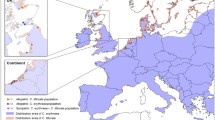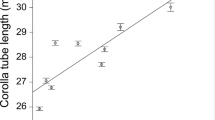Abstract
Floral isolation has been considered to be an important reproductive mechanism governing the species diversification in many genera. In a classic example Aquilegia, sympatric species from North America with diverse floral traits are generally associated with specialized pollinators that prohibit interspecific hybridization. It remains unclear whether species diversification in the genus from Eurasia is also maintained by floral isolation. We investigated floral phenology, floral characteristics and pollinators in three sympatric Aquilegia species (A. ecalcarata, A. incurvata and A. yabeana) in the Qinling Mountains, Shanxi Province, China from 2001 to 2005. The spurless A. ecalcarata flowers earlier than the other two species with nectar spurs but their floral phenology overlaps. Major pollinators of A. ecalcarata are syrphid flies while bumblebees are major for A. incurvata and A. yabeana. Therefore our observations confirm that mechanical isolation through differential pollinators could contribute reproductive isolation between spurless and spurred species, as demonstrated by studies from North America. Whether floral isolation plays a major role in the reproductive isolation between two spurred species (A. incurvata and A. yabeana), however, remains to be seen. Further studies are required to quantify the potential role of geographical isolation because they occupy different habitats.
Similar content being viewed by others
References
Armbruster WS (1993). Evolution of plant pollination systems: hypotheses and tests with the neotropical vine Dalechampia. Evolution 47: 1480–1505
Brunet J and Charlesworth D (1995). Floral sex allocation in sequentially blooming plants. Evolution 49: 70–79
Brunet J and Eckert CG (1998). Effect of floral morphology and display on outcrossing in blue columbine, Aquilegia caerulea (Ranunculaceae). Funct Ecol 12: 596–606
Campbell DR, Waser NM and Melendez-Ackerman E (1997). Analyzing pollinator-mediated selection in a plant hybrid zone: hummingbird visitation patterns on three spatial scales. Amer Naturalist 149: 295–315
Chase VC and Raven PH (1975). Evolutionary and ecological relationships between Aquilegia formosa and A. pubescens (Ranunculaceae), two perennial plants. Evolution 29: 474–486
Cresswell JE (1998). Stabilizing selection and the structural variability of flowers within species. Ann Bot 81: 463–473
Dafni A (1992). Pollination ecology: a practical approach. Oxford University Press, New York
Fenster CB and Martén-Rodríguez S (2007). Reproductive assurance and the evolution of pollination specialization. Int J Pl Sci 168: 215–228
Fenster CB, Armbruster WS, Wilson P, Dudash MR and Thomson JD (2004). Pollination syndromes and floral specialization. Annual Rev Ecol Evol Syst 35: 375–403
Fulton M and Hodges SA (1999). Floral isolation between Aquilegia formosa and Aquilegia pubescens. Proc Roy Soc Lond B 266: 2247–2252
Gardner M and Macnair M (2000). Factors affecting the co-existence of the serpentine endemic Mimulus nudatus Curran and its presumed progenitor, Mimulus guttatus Fischer ex DC. Biol J Linn Soc 69: 443–459
Grant V (1949). Pollination system as isolation mechanisms in angiosperm. Evolution 3: 82–97
Grant V (1952). Isolation and hybridization between Aquilegia formosa and A pubescens. Aliso 2: 341–360
Grant V (1992). Floral isolation between ornithophilous and sphingophilous species of Ipomopsis and Aquilegia. Proc Natl Acad Sci USA 89: 11828–11831
Grant V (1993). Effects of hybridization and selection on floral isolation. Proc Natl Acad Sci USA 90: 990–993
Grant V (1994). Modes and origins of mechanical and ethological isolation in angiosperms. Proc Natl Acad Sci USA 91: 3–10
Griffin SR, Mavraganis K and Eckert CG (2000). Experimental analysis of protogyny in Aquilegia canadensis (Ranunculaceae). Amer J Bot 87: 1246–1256
Herlihy CR and Eckert CG (2004). Experimental dissection of inbreeding and its adaptive significance in a flowering plant, Aquilegia canadensis (Ranunculaceae). Evolution 58: 2693–2703
Hodges SA (1997). Floral nectar spurs and diversification. Int J Pl Sci 158(6 suppl): S81–S88
Hodges SA and Arnold ML (1994a). Floral and ecological isolation between Aquilegia formosa and Aquilegia pubescens. Proc Natl Acad Sci USA 91: 2493–2496
Hodges SA and Arnold ML (1994b). Columbines: A geographically widespread species flock. Proc Natl Acad Sci USA 91: 5129–5132
Hodges SA, Whittall JB, Fulton M and Yang JY (2002). Genetics of floral traits influencing reproductive isolation between Aquilegia formosa and Aquilegia pubescens. Amer Naturalist 159: S51–S60
Hodges SA, Fulton M, Yang JY and Whittall JB (2003). Verne Grant and evolutionary studies of Aquilegia. New Phytol 161: 113–120
Huang S-Q, Tang L-L, Yu Q and Guo Y-H (2004). Temporal floral sex allocation in protogynous Aquilegia yabeana contrasts with protandrous species: support for the mating environment hypothesis. Evolution 58: 1131–1134
Ippolito A, Fernandes GW and Holtsford TP (2004). Pollinator preference for Nicotiana alata, N forgetiana, and their F1 hybrids. Evolution 58: 2634–2644
Macior LW (1966). Foraging behavior of Bombus (Hymenoptera: Apidae) in relation to Aquilegia pollination. Amer J Bot 53: 302–309
Miller RB and Willard CL (1983). The pollination ecology of Aquilegia micrantha (Ranunculaceae) in Colorado. Southw Naturalist 28: 157–164
Pellmyr O (1986). Three pollination morphs in Cimicifuga simplex: incipient speciation due to inferiority in competition. Oecologia 68: 304–307
Prazmo W (1965). Cytogenetic studies on the genus Aquilegia. IV. Fertility relationships among the Aquilegia species. Acta Soc Bot Poloniae 34: 667–685
Ree RH (2005). Detecting the historical signature of key innovations using stochastic models of character evolution and cladogenesis. Evolution 59: 257–265
Schemske DW and Bradshaw HD (1999). Pollinator preference and the evolution of floral traits in monkeyflowers (Mimulus). Proc Natl Acad Sci USA 96: 11910–11915
Waser NM (2001). Pollinator foraging and plant speciation: looking beyond the “ethological isolation” paradigm. In: Chittka, L and Thomson, JD (eds) Cognitive ecology of pollination, pp 318–335. Cambridge University Press, Cambridge
Yu Q and Huang S-Q (2006). Flexible stigma presentation assists context-dependent pollination in a wild columbine. New Phytol 169: 237–242
Author information
Authors and Affiliations
Corresponding author
Rights and permissions
About this article
Cite this article
Tang, LL., Yu, Q., Sun, JF. et al. Floral traits and isolation of three sympatric Aquilegia species in the Qinling Mountains, China. Plant Syst. Evol. 267, 121–128 (2007). https://doi.org/10.1007/s00606-007-0574-6
Received:
Accepted:
Published:
Issue Date:
DOI: https://doi.org/10.1007/s00606-007-0574-6




